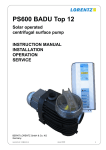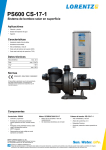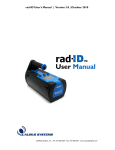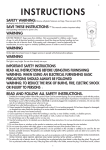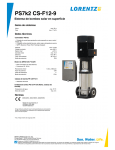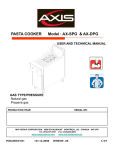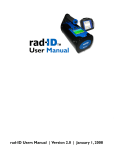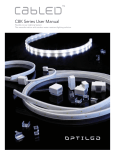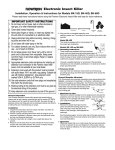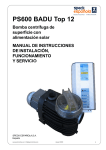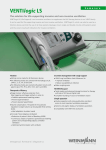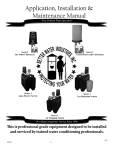Download PS150 BooSt Solar Water Pump Systems
Transcript
PS150 Boost Solar Water Pump Systems Manual for Installation, Operation, Maintenance Contents 1 Introduction 1 Introduction. .. . .. . .. . .. . .. . .. . .. . .. . .. . .. . .. . .1 Thank you for purchasing a LORENTZ PUMP. 2 IMPORTANT SAFETY INSTRUCTIONS. . . . . . . . . . . . . 2 Before you begin Check the model numbers of all the components of your system, and verify that they are the items that you ordered. Also check against the pump specifications and performance charts (end of this manual) to be sure the system is appropriate for your application. 3 Product Description. . . . . . . . . . . . . . . . . . . . . . . . . . . . 3 4 Placement. . . . . . . . . . . . . . . . . . . . . . . . . . . . . . . . . . . . . 3 4.1 Location . .. . .. . .. . .. . .. . .. . .. . .. . .. . .. . .. . .. . 3 4.2 Installation Position. . . . . . . . . . . . . . . . . . . . . . . . . . . .3 5 Installation . . . . . . . . . . . . . . . . . . . . . . . . . . . . . . . . . . . .4 5.1 General. . . . . . . . . . . . . . . . . . . . . . . . . . . . . . . . . . . . . . .4 5.1 Filtering. . . . . . . . . . . . . . . . . . . . . . . . . . . . . . . . . . . . . . .4 5.2 Plumbing Design. .. . .. . .. . .. . .. . .. . .. . .. . .. . .. 4 5.3 Installation in Drilled Wells . .. . .. . .. . .. . .. . .. . .. 5 5.4 Freeze Protection . . . . . . . . . . . . . . . . . . . . . . . . . . . . . .5 5.5 Controller Input Wiring. . . . . . . . . . . . . . . . . . . . . . . . .5 5.6 Electrical Installation – Terminals . . . . . . . . . . . . . . . .6 5.7 Battery-based Systems . . . . . . . . . . . . . . . . . . . . . . . . .6 5.8 Grounding and Lightning Protection . . . . . . . . . . . . .6 5.9 Wire Sizing. . . . . . . . . . . . . . . . . . . . . . . . . . . . . . . . . . . .6 Please fill in the SYSTEM REPORT This will be essential information if any problems occur. 1 Read the manuals of pump end, charger (optionally) and other components used in your system. 6 Operating the Pump . .. . .. . .. . .. . .. . .. . .. . .. . .. 7 7 Automatic Control For Full-Tank Shutoff. . . . . . . . .8 8 Pressurising Systems . . . . . . . . . . . . . . . . . . . . . . . . . . .9 Pressure Switch Wiring. .. . .. . .. . .. . .. . .. . .. . .. . .. . 9 Pressure Setting . .. . .. . .. . .. . .. . .. . .. . .. . .. . .. . .. . 9 9 Maintenance. . . . . . . . . . . . . . . . . . . . . . . . . . . . . . . . . 10 10 System Wiring. .. . .. . .. . .. . .. . .. . .. . .. . .. . .. .11 10.1 12 V DC Battery System. . . . . . . . . . . . . . . . . . . . . . 11 10.2 24 V DC Battery System. . . . . . . . . . . . . . . . . . . . . . 11 10.3 System Wiring for 12 – 24 V DC Systems in PV-direct Operation. .. . .. . .. . .. . .. . .. . .. . .. . .. . .. . .. . .12 11 Trouble Shooting . .. . .. . .. . .. . .. . .. . .. . .. . .. .13 12 Dimensions . . . . . . . . . . . . . . . . . . . . . . . . . . . . . . . . . 14 13 System Report . . . . . . . . . . . . . . . . . . . . . . . . . . . . . . 15 v110801 BERNT LORENTZ GmbH & Co. KG Kroegerskoppel 7, 24558 Henstedt-Ulzburg, Germany, Tel. +49 (0) 4193 7548 - 0, Fax - 29, www.lorentz.de Errors excepted and possible alterations without prior notice. Sun. Water. Life. 2 IMPORTANT SAFETY INSTRUCTIONS READ AND FOLLOW ALL INSTRUCTIONS! When installing and using this electrical equipment, basic safety precautions should always be followed, including the following: WARNING – To reduce the risk of injury, do not permit children to use this product unless they are closely supervised at all times. WARNING – To reduce the risk of electric shock, replace damaged cord immediately. WARNING – It must be assured that all grounds are connected properly and that the resistances do not exceed the local codes. SAVE THESE INSTRUCTIONS! The manual contains basic instructions which must be observed during mounting, operation and maintenance. Therefore the manual should be carefully read before installation and startup by the person in charge of the installation as well as by all other technical personnel/operators and should be available at the installation site at all times. Personnel Qualification and Training – All personnel for the operation, maintenance, inspection and installation must be fully qualified to perform that type of job. Responsibility, competence and the supervision of such personnel must be strictly regulated by the user. Should the available personnel be lacking the necessary qualification, they must be trained and instructed accordingly. If necessary, the operator may require the manufacturer/supplier to provide such training. Furthermore the operator/user must make sure that the personnel fully understands the contents of the manual. Dangers of Ignoring the Safety Symbols – Ignoring the safety directions and symbols may pose a danger to humans as well as to the environment and the machine itself. Non-observance may void any warranties. Non-observance of safety directions and symbols may for example entail the following: Failure of important functions of the machine/plant; failure of prescribed methods for maintenance and repair; endangerment of persons through electrical, mechanical and chemical effects; danger to the environment because of leakage of hazardous material; danger of damage to equipment and buildings. Safety Directions for Maintenance, Inspection and Assembly Work – It is the user’s responsibility to make sure that all maintenance, inspection and assembly work is performed exclusively by authorized and qualified experts sufficiently informed through careful perusal of the Operating Instructions.The accident prevention regulations must be observed. Basically, all work on the machine is to be performed while the machine is not in operation. The sequence for shutting the machine down described in the manual must be strictly observed. Pumps or pump units handling hazardous liquids must be decontaminated. Immediately upon completion of the work, all safety and protective equipment must be restored and activated. Unauthorized Changes and Manufacturing of Spare Parts – Any conversion or changes of the machine may only be undertaken after consulting the manufacturer. Original spare parts and accessories authorized by the manufacturer guarantee operational safety. Using non-authorized parts may void any liability on the part of the manufacturer in case of consequential damage. Unauthorized Operation – The operational safety of the machine delivered is only guaranteed if the machine is used in accordance with the directions contained in manual. Limits stated in the data sheets may not be exceeded under any circumstances. Cited Standards and other Documentations – DIN 4844 Part 1 Safety marking; Safety symbols W 8, Supplement 13; DIN 4844 Part 1 Safety marking; Safety symbols W 9, Supplement 14 Safety-oriented Operation – The safety directions contained in the manual, existing national regulations for the prevention of accidents as well as internal working-, operational- and safety-regulations of the operator/user must be observed at all times. Transportation and Intermediate Storage – Prolonged intermediate storage in an environment of high humidity and fluctuating temperatures must be avoided. Moisture condensation may damage windings and metal parts. Non-compliance will void any warranty. General Safety Directions for the Operator/ User – If hot or cold machine parts pose a danger, such parts must be protected by the operator/ user against contact with personnel. Protective covers for moving parts (e.g. coupling) must not be removed when the machine is running. Leakages (e.g. at the shaft seal) of hazardous pumping media (e.g. explosive, toxic, hot liquids) must be disposed of in such a way that any danger for personnel and the environment is removed. All government regulations must be observed at all times. Any danger to persons etc. by electrical energy must be excluded. (For details see e.g. regulations of VDE and the local utilities). Do not attempt to use the controller for any purpose other than LORENTZ PS pump systems. Do not attempt to run the motor without controller. Ensure all power sources are disconnected when working on the system. Follow all appropriate electrical codes. There are no user-serviceable parts inside the motor or the controller. Explanation of Warning Symbols WARNING disregard might lead to injury or damage the installation CAUTION recommended to avoid disfunction or premature ageing of the pump etc. v110801 BERNT LORENTZ GmbH & Co. KG Kroegerskoppel 7, 24558 Henstedt-Ulzburg, Germany, Tel. +49 (0) 4193 7548 - 0, Fax - 29, www.lorentz.de Errors excepted and possible alterations without prior notice. Sun. Water. Life. 2 3 Product Description 4 Placement PS150 BOOST is a highly efficient pump system which provides city water pressure. It is economical for domestic water supply, (drip-) irrigation, livestock, water transfer to remote places and many other applications. It is a surface pump which must not be submersed. 4.1 Location The pump of PS150 BOOST is a positive displacement vane type pump. Controller Location Place the controller close to the solar array, not the pump. This will reduce the risk of lightning damage. If it is outdoors, mount the controller in a vertical position to assure that rain will not enter the box. The PS150 BOOST brushless DC motors are specially made for this system. The motor is using very advanced raw earth magnet technology, handmade wiring for highest copper density and does not need wearing brushes. This results in an exceptionally high efficiency with low temperature dissipation. PS150 BOOST can either be used in a battery system with voltages of 12 V DC or 24 V DC or as a solar-direct system. Both modes use the same controller PS150. In battery mode, the solar battery is charged during daylight hours using an independent charge controller. The charger works effectively during reduced sunlight conditions when direct pump operation is not possible. The energy stored in the battery is available to operate the pump at any time, day or night and during periods of bad weather. Extended bad weather periods with water demands of up to 10m3 per day will be reliably bridged due to the high system efficiency even with low capacity batteries. WARNING – PS150 Boost pumps must NOT be submerged in water, or rained or dripped on. Protection from heat Electronic devices are most reliable when they are protected from heat. Mount the controller in the shade of the mid-day sun. An ideal location is directly under the solar array or in a nearby shaded location. An alternative is to fold a piece of sheet metal so that it mounts behind the controller and curves over it to provide shade. This provides protection in extremely hot climates. Battery system Place the controller near the batteries but safely isolated from the battery terminals and from corrosive gases. Batteries must be in a cool location for best longevity and enclosed for cleanliness and safety. WARNING – HUMIDITY If the pump is installed in a humid space, effective ventilation and aeration must be provided for, in order to prevent condensation. WARNING – Cooling In case of very small installation spaces, the natural cooling of the air may be so insignificant that, also there, ventilation and aeration is necessary in order not to exceed the environmental temperature of 50°C. The pump is manufactured from non-corrosive material (stainless steel, brass, aluminum). Operating noises Make sure, by applying appropriate measures, that the environment will not be impaired by any sound produced by the pump. Space During installation, make sure that there is enough space available to permit subsequent disassembly of the motor unit. WARNING – Pump might heat up in operation. Pump must not be installed on combustible dangerous surface, but e.g. on cement surface or marble surface. Connecting the pump to the foundation Fastening the pump to the foundation should be effected exclusively by means of bolts, threads (or dowels) in order to avoid blocking the removal of the motor unit. WARNING – Inlet- and outlet-pipes must be mounted to the pump housing free of tension. 4.2 Installation Position The pump may be mounted horizontally or vertically. WARNING – lf vertically, FACE THE PUMP HEAD DOWNWARD. Rigid mounting is not required in most installations. In a non battery system, starting is gradual and the pump does not jerk with the start. In a battery system, it will jerk slightly, but simply mounting it to a small wooden board is sufficient to stabilize it. The pump may be hung vertically on a rope. Observe the pump and see that it is not likely to overstress or loosen pipes as it starts. CAUTION – Do not mount the pump directly to a wall or wood floor in your home. It will increase the noise. Changing the pump head position lf you wish to face the pump’s fittings sideways or downwards, please do. You may rotate pump head to a different position by loosening the clamp screw that secure the pump to the motor. BEFORE installing the pump, drop a teaspoon of water into the inlet and run the pump. It may be installed either max. 3 m below (gravity feed) or above (suction mode) of the water level. Thereby the geodetic head between liquid level and pump inlet must not exceed 3 m. The suction lift may be significantly reduced by flow resistance in the suction line (if the pipes are very long and/or insufficiently dimensioned). Table 1: Technical Data of Controller system PS150 Boost 60/125/240/330 max. power input (Vmp)* [V DC] >34 [W] 250 open circuit voltage (Voc) [V DC] 50 input voltage battery [V DC] 12/24 battery low voltage disconnect [V DC] 11/22 battery restart voltage [V DC] 12/24 motor power enclosure type ambient temperature controller IP54 weatherproof (NEMA type 3R) motor IPX4 weatherproof (NEMA type 3) storage [°C] –30 to +55 operation of controller [°C] –20 to +50 operation of pump [°C] 0 to +50 *)PV modules at standard test condition: AM = 1.5, E = 1,000 W/m2, cell temperature: 25 °C v110801 BERNT LORENTZ GmbH & Co. KG Kroegerskoppel 7, 24558 Henstedt-Ulzburg, Germany, Tel. +49 (0) 4193 7548 - 0, Fax - 29, www.lorentz.de Errors excepted and possible alterations without prior notice. Sun. Water. Life. 3 5 Installation 5.1 General WARNING – All electrical connections should be performed by a qualified experts only! Please make sure that the electrical installation has a disconnecting device, which allows disconnecting from the power supply with a minimum of 3 mm contact gap at each pole. This pump is built according to Protection Class 1. WARNING – The ambient temperature must not exceed max. 50°C. 5.1 Filtering WARNING – Your pump is a PRECISION MACHINE. Traces of sand, clay, rust or other solids will cause rapid wear or immediate damage. lf your water is CRYSTAL CLEAR ALL THE TIME, our fine intake strainer will provide sufficient protection. lf you have an intake strainer already, it is probably not fine enough openings must be no more than several hairs wide -, or additional filtration is required. Since water conditions are subject to change, it is good insurance to use a filter regardless. A 30 INCH INTAKE FILTER/FOOT VALVE is necessary for pumps lowered into wells. Otherwise a INLINE FILTER is best, installed close to the pump’s intake. lf filters are expected to clog often, maintenance may be minimized by plumbing two or more filters in parallell The INLINE FILTER has a clear bowl so its condition may be observed. CAUTION – KEEP SPARE CARTRIDGES HANDY! Filter cartridges are available from your dealer or the factory. 9 7/8 inch cartridges for the INLINE filter may also be obtained from local water system suppliers. The 10-20-micron “spun polypropylene” type is best. Paper filters have less capacity. The kind that looks like string has more resistance to flow. Carbon taste and odor cartridges have less capacity for dirt, more resistance to flow, and cost more. Use them only if you have, taste and odor problems. A filter cartridge may look clean and still be clogged, due to fine silt embedded in the fibers. If the pump, becomes increasingly noisy over time, it is usually due to a clogging filter cartridge. On the other hand, a cartridge that looks discoloured may not be clogged, as long as your pump runs quietly, the filter is OK. Use pump noise to indicate the need to change cartridges. Iron pipes or fittings will introduce abrasive rust particles if installed on the intake side of the pump (they rust, every if galvanized). Pipe that is dirty inside (even new pipe) or has mineral deposits in it will also introduce dirt. Dirt is introduced as pipe joints are assembled, especially in a trench. CAUTION – Make sure inlet lines and fittings are FLUSHED CLEAN before hooking up to pump. The INLINE FILTER may have a red push button valve to release pressure for maintenance. If filter is placed more than a few feet higher than water source (at lowest level) the suction may pull the valve open and introduce air. Prevent this by sealing around the push button with silicone sealant or epoxy, or replace the button with a nut, tightened down. 5.2 Plumbing Design WARNING – New pumps are packed with foam plugs to prevent contamination. REMOVE FOAM PLUGS BEFORE CONNECTING PIPES. HANDLE YOUR PUMP CAREFULLY! Never hammer on it, clamp it in a vice or drop it. Minimize suction lift to max. 3 m total pressure loss (2 m for pumps with flow rate greater than 400 l/h). The practical suction limit for any pump is 6 m (20 vertical ft) at sea level (subtract 0.3 m/1 ft for every 300 m/1,000 ft of elevation). The more you minimize suction lift, the more reliable and quiet your pump will be. Just be sure the motor will not be submerged if the water level rises, or it will be ruined. Your pump may be placed downhill from your water source, if feasible. Intake Pipe The intake pipe may run any reasonable horizontal distance, although it is best to keep it short. Use large pipe for the intake (1 to 1 ½” for larger booster pumps). Slope the intake line from the water source UP toward the pump. Avoid humps in the intake line. They trap air pockets which can block the flow. CAUTION – Avoid leaks in suction line. Otherwise the pump will prime insufficiently or not at all. Leaks in the suction line are hard to locate and will cause constant problems. The intake pipe must be sized generously to allow no more than a slight pressure drop at peak flow rate, or pump will be noisy and will wear rapidly. Use pipe reducer fittings to adapt your pump’s inlet or outlet to larger pipe size where necessary. Excessive pipe sizing will do no harm. WARNING – Intake must not be restricted by undersized pipe, excessive suction lift, or a clogged filter. WARNING – Excessive suction at the pump intake causes cavitation (formation and implosion of vapor bubbles). This causes very loud buzzing noise and radid pump wear. A slight buzzing noise is acceptable, if it cannot be avoided. CAUTION – Do not use thin wall hose or soft tubing on the pump’s intake. It may collapse under suction and restrict the flow. CAUTION – Do not use polyethylene pipe (black flexible) for the suction either. It is prone to slight leakage at the fitting. Inline filter should be mounted HORIZONTALLY and as low as possible. This prevents any air trapped in it from blocking the water flow. Be sure to leave some space below it for a pan, to catch water when replacing the filter cartridge. v110801 BERNT LORENTZ GmbH & Co. KG Kroegerskoppel 7, 24558 Henstedt-Ulzburg, Germany, Tel. +49 (0) 4193 7548 - 0, Fax - 29, www.lorentz.de Errors excepted and possible alterations without prior notice. Sun. Water. Life. 4 5.3 Installation in Drilled Wells Foot valve The foot valve is a check valve installed at the water intake. It is required in any case where the pump is located higher than the low water level in the source. A high quality spring loaded type is recommended to avoid loss of prime. A check valve allows water to flow one way and not the other. Be sure to install it the right way. Priming the Pump Priming a pump means filling its intake and suction line completely with water. This must be done if the pump is mounted higher than the water source. A removable plug or a valve must be installed at the highest point is in the suction plumbing. Prime the pump and intake line by pouring water into the opening until it is completely full. Your foot valve prevents loss of prime by not allowing water to flow back into the water source. The pump will create enough vacuum to self-prime to around 3 m/10 ft (less at high elevations), but only when it is in new condition and wet inside. A priming plug is always recommended if the pump is to be located higher than the water source. Using a good quality ball valve instead of a plug is recommended, especially if frequent priming is expected. Check Valve at the pump outlet A check valve at the pump outlet is required if there is more than a 10 m/30 ft lift above the pump, or in any pressurizing system. This allows the pump to start easier. It also prevents back flow when changing filter cartridges. Pipe Unions lf you run rigid piping (copper or PVC) directly to the pump, unions are required. Unions make pump replacement easy, without the need to cut and re-solder or re-glue the pipe. “Copper Flex Connectors” commonly used for water heaters may be used instead. Inside a 6 inch well casing, special elbow adapters are required. The elbows fit ½” polyethylene (black flex) pipe. Measure carefully to determine the length of pipe you need. Substract 1.5% to allow for pipe and rope stretch. A priming plug is not needed. Before lowering the pump, place the intake into a bucket of clean water and run the pump until water exits. Now it is primed. A “pitless adapter” may be optimum for freeze protection. Check with your local well supplier for details. Polyethylene pipe comes in rolls, and is inexpensive and quite freeze tolerant. Use with plastic adapters and secure with all stainless hose clamps (obtain such clamps from a pipe supplier rather than automotive supplier). lf pipe does not stretch tightly over fittings, warm it with a torch or hot water then tighten clamps firmly with a wrench. Keep extra clamps handy in case you strip one. 5.4 Freeze Protection To prevent freezing of exposed pipes consider the simple method of drilling a small “weep hole” in the outlet pipe, below ground level. The pipe will drain when pumping stops but a small amount of water will be wasted during pumping. Set the outlet pipe to spill into the top of the tank so that the tank will not drain, or install a check valve and “vacuum breaker” to allow pipe to drain. Water will drain back through the pump if allowed to, but it will do so slowly. lf this is desired, do not use any check valves or foot valve. Pump must have suction draw of no more than about 3 m/10 ft, however. lf pump drainage is required, position pump vertically (head downward) or horizontally with intake and outlet facing downward. WARNING – Take every precaution to prevent pump freezing. The forged brass pump head will survive most light freezes, but a hard freeze may damage it. WARNING – lf you insulate your pump for freeze protection, keep the motor exposed so it won’t overheat. 5.5 Controller Input Wiring WARNING – Do not touch the controller input or motor wires together to test for a spark. Connect the battery (12 V DC or 24 V DC) directly with the and – terminal of the controller. Do not use the load terminals of the charge controller as they maybe not strong enough to allow the start current to flow. Motor direction The cable ends are labelled 1, 2, 3. Connect them in this sequence with the pump controller to have the correct direction of turning (clockwise). Check from the fan of the motor. Looking on the fan of the motor the direction is counter clock wise, see also the arrow. Changing the polarity of the DC (plus and minus) input of the controller will not change the direction of turning! Only changing two of the three motor phases will do. WARNING – TEST THE VOLTAGE before connecting power to the controller. Voltage (open circuit) must not exceed 50 V DC. (Even in cloudy weather, the open circuit voltage will be near maximum.) Some thin-film PV-modules may produce excessive voltage, specially when they are new. If the open circuit voltage exceeds 50 V, DO NOT connect power to the controller. Contact your supplier. WARNING – Do not apply a direct connection or an amp meter between + and – when the controller is connected. A short circuit here will cause a strong discharge. WARNING – SOLAR-DIRECT systems only — Do not connect any electrical load to the solar array if it is not part of the LORENTZ pump system. Connection of a battery charger, active solar tracker controller, electric fence charger, or other load simultaneously with LORENTZ PS systems may “confuse” the controller and prevent proper operation. WARNING – A cord- and plug-connected unit shall be provided with a permanently attached flexible cord of a water-resistant type, Type SEW, SEOW, SJW, SJOW, SJEW, SJEOW, SJTW, SJTOW, SOW, STW, or STOW. When the pump is connected by cable at field, use extra hard type cable for connections. v110801 BERNT LORENTZ GmbH & Co. KG Kroegerskoppel 7, 24558 Henstedt-Ulzburg, Germany, Tel. +49 (0) 4193 7548 - 0, Fax - 29, www.lorentz.de Errors excepted and possible alterations without prior notice. Sun. Water. Life. 5 5.6 Electrical Installation – Terminals 5.7 Battery-based Systems See figure 1 Short circuit protection Install a fuse or circuit breaker near the power source. Use a 30 A circuit breaker or a time-delay (slow blow) fuse installed into a rain tight disconnect switch. The purpose of this protection is for safety in case of a wiring fault, and to provide a means of disconnect when installing or maintaining the system. PS150 controllers have electronic over-current protection against motor overload. Power IN For PV-direct systems, a two-pole disconnect switch may be installed between the solar array and the controller. Switch it off to prevent shock and arc burn hazard during installation and maintenance, or if the system will be shut down for the season. For battery systems: Connect the controller directly to the plus and minus terminals of the battery. Do not connect to the load terminals of the charger as they may be not strong enough to provide the starting current. A 30 A slow blow fuse must be installed between the controller and the battery. Ground Connect the ground wire to the ground connection in the controller. Grounding helps to prevent shock hazard if there is a fault in the motor. L1 – L2 – L3 ECDRIVE requires four-conductor (four-wire) cable between the controller and the motor. The three wires L1, L2 and L3 carry power. The fourth wire carries ground. To reverse direction of rotation reverse any two wires. Low-voltage disconnect function Lead-acid batteries can be permanently damaged by over-discharge when the voltage falls below a critical point. An additional charger is needed for charging the batteries. To prevent this, the PS battery system controller will turn off at low voltage, and turn back on only after the battery has recovered significantly. The set points are: System PS150 Boost No disconnect switches must be installed in power wires between motor pump controller. Connecting the motor wire to the switched-on controller might irreparably damage it. Such damages are excluded from the warranty. 5.8 Grounding and Lightning Protection Voltage OFF ON 12 V DC 11 V DC 12 V DC 24 V DC 22 V DC 24 V DC A controller in disconnect mode can be reset manually by turning off/on, but it will quickly disconnect again if the battery is not gaining a substantial recharge. No. 1 and 2 In order to protect the pump from being damaged by dry running connect one well probe cable to each terminal. If dry run protection is not needed, short cut these two terminals. No. 3, 4 and 5 Connect any kind of external switch (NO or NC type) for remote control of the controller. In case no switch is used the terminals No. 4 and 5 have to be connected with a short cable (factory setting). In case a NOswitch is used (connected to the terminals No. 3 and 4) the short cable (connecting the terminals No. 4 and 5) must remain installed. No. 6 and 7 Connect these two terminals to switch the controller to battery mode. The motor will be switched OFF by the controller if the input voltage is below 11 V DC (for 12 V DC systems) or 22 V DC (for 24 V DC systems) respectively in order to protect the battery. If the battery voltage increases to 12 V DC (for 12 V DC systems) or 24 V DC (for 24 V DC systems) respectively, the motor will be switched ON automatically. Figure 1: Terminals of PS150 controller Terminals of the controller WARNING – Install proper grounding for safety and lightning protection. A long wire run may act like an antenna, receiving induced surges of high voltage when lightning is present. Proper grounding will greatly reduce risk of lightning damage to your power system. A proper ground system consists of a minimum of one 2.5 m/8 ft copper plated ground rod driven into the ground, preferably in a moist spot close to the PV array. Or, if you have a steel well casing, drill and tap a bolt hold to make good contact to it. In a dry, lightning prone location, use more than one ground rod at least 3 m/10 ft apart. Bury bare copper wire between them. Use min, 4 mm2/#8 ground wire (larger for distances exceeding 6 m/20 ft). In a rocky location, where ground rods can’t be driven, bury (as much as feasible) 45 m/150 ft (total) of bare copper wire, radiating out in two or more directions from the PV array. Try to contact moist earth as much as possible. WARNING – Use only the copper or bronze electrical connectors designed for grounding application, and BE SURE ALL CONNECTIONS ARE TIGHT. Connect your ground system to the METALLIC FRAME of your PV array via min. 4 mm2/#8 copper wire. Also ground metallic support structures and electrical enclosures. 5.9 Wire Sizing Do not use undersized wire! Splice it to a larger size of wire if your wire run is longer than 2 m/7 ft. Refer to a wire sizing table. Consult a low voltage wire size chart to size the cable size from the array to the controller or call your dealer or the factory for recommendations. Excessive voltage drop will slow the pump down, but if it is unavoidable. It will NOT cause any harm to the motor. Wire sizing for the DC circuit Wire must be sized for no more than 5% voltage drop at 30 A (starting). Refer to a wire sizing chart for 12 V DC or 24 V DC, or follow these examples: PV-direct systems AWG #10 wire to maximum distance of 50 ft Metric: 4 mm2 to max. 15 m Battery systems AWG #10 wire to maximum distance of 65 ft Metric: 6 mm2 to max. 20 m GREATER LENGTHS For each increase by 50 %, use next larger wire size v110801 BERNT LORENTZ GmbH & Co. KG Kroegerskoppel 7, 24558 Henstedt-Ulzburg, Germany, Tel. +49 (0) 4193 7548 - 0, Fax - 29, www.lorentz.de Errors excepted and possible alterations without prior notice. Sun. Water. Life. 6 6 Operating the Pump WARNING – NEVER LET THE PUMP RUN DRY, NOT EVEN FOR THE PURPOSE OF CHECKING THE DIRECTION OF ROTATIONWater is the lubricant for your pump. lf it runs completely dry, it will overheat and fail. As an option you can install a well probe to terminals 1-2 to shut the pump off if water source is low. WARNING – Make sure pump turns freely, especially after extended periods of down-time. Make sure the mechanical seal does not leak. This explains the function of the switch and the indicator lights on board of the pump controller. See figure 2 SWITCH: POWER ON/OFF When switched off/on during operation, it resets all system logic. BATTERY LOW (tank light flashes) Battery systems only – battery voltage fell to 11 V DC (12 V DC systems) or 22 V DC (24 V DC systems), and has not yet recovered to 12 V DC (12 V DC systems) or 24 V DC (24 V DC systems). RPM indication Pump speed can be read off by the flashing sequence of the Pump ON LED. Indication LED ON > 300 one flash > 500 two flashes > 1,000 four flashes > 1,250 five flashes > 1,500 2. SYSTEM (green) The controller is switched on and the power source is present. In low-power conditions, the light may show even if there is not enough power to run the pump. 3. PUMP ON (green) Motor is turning. Sequence of flashing indicates pump speed. See below sequence When pump stops from a sudden shadow on the solar array If a shadow suddenly passes over the array, like if you walk in front if it, the controller will lose track of the input voltage. This does not indicate a problem. The pump will attempt to restart after the normal delay. Time delays 1. Be sure there is not a closed valve or other obstruction in the water line. Fill the pump with clean water until the water level reaches the inlet connection. Coat the O-ring seal with vaseline, close the lid by hand and make sure that it is well in the housing groove. Otherwise the pump will prime insufficiently or not at all. Switch on the array disconnect switch, and toggle the power switch on the controller. It is normal to leave the switches on at all times, unless you desire to have the system off. 4. After pump stops due to insufficient sunshine – 120 seconds After full-tank float switch resets – 2 to 3 seconds After low-water probe regains contact with water in the source – 20 minutes but the indicator light will slowly flash for the rest of the solar day, or until power is disrupted or the controller is turned off/on. Battery systems – after low voltage disconnect point is reached, delay to stop pump – a few SECONDS. After voltage recovers, delay to re-connect – a few SECONDS To force a quick start To test or observe the system, you can bypass the normal time delays. Switch the POWER switch off then on again. The pump should start immediately if sufficient power is present. A solar-direct pump should start under the following conditions 1. 2. 3. 4. TANK FULL (red) Pump is turned off by action of the remote float switch (or pressure switch or manual switch), whichever is wired to the “remote float switch” terminals. When pump runs slowly (PUMP ON) under weak sun conditions the pump may spin without lifting water all the way to the outlet. This is normal. 2. 3. Starting the pump 1. WELL DRY (red) The water source dropped below the level of the low-water probe. After the water level recovers, the pump will restart, but this light will slowly flash until the sun goes down, power is interrupted, or the POWER switch is reset. This indicates that the water source ran low at least once since the previous off/on cycle. > 750 three flashes Indicator lights OVERLOAD (red) RPM When sunshine is insufficient When sunshine on the array is present, but too weak for the pump to run, it will attempt to start about every 120 seconds. During each attempt, you will see the PUMP ON light come on. 5. clear sunshine at an angle of about 20° or more from the surface of the solar array cloudy conditions, if the sunshine is bright enough to cast some shadow low-water probe submersed in the water source (or bypassed in the controller) – Water-low light OFF full-tank float switch is not responding to a full tank – Tank-Full light OFF battery system only – voltage is higher than the lowvoltage disconnect point of 11 V DC (12 V DC systems) or 22 V DC (24 V DC systems). LEDs for Monitoring Figure 2: Monitoring v110801 BERNT LORENTZ GmbH & Co. KG Kroegerskoppel 7, 24558 Henstedt-Ulzburg, Germany, Tel. +49 (0) 4193 7548 - 0, Fax - 29, www.lorentz.de Errors excepted and possible alterations without prior notice. Sun. Water. Life. 7 7 Automatic Control For Full-Tank Shutoff We recommend the use of a float switch or other means to prevent overflow of your tank. This will stop the pump when the tank is full, then reset when the level drops. This conserves ground water, prevents overflow, and eliminates unnecessary pump wear. PS controllers allow the use of small signal cable to a remote float switch, even if the tank is a long distance away. Float switch requirements 1. 2. A switch must be used, not wet electrodes. The preferred system requires a float switch to MAKE contact on rise to turn the pump OFF. This is called “normally open” (N.O.). It may be commercially labeled as a “pump down” switch, but here it works in reverse, to allow pumping up. Float switch cable requirements 1. 2. 3. 4. sealed cable clamp Two wires are needed. Minimum wire size #18 AWG (1mm²). This is good for a distance as far as 2,000 feet (600 m). The cable must be suitable for its environment. If it must run a long distance, use twisted-pair shielded cable to reduce the chance of damage from lightning-induced surge. Grounding shielded float switch cable If you use shielded cable, connect the shield to ground AT THE CONTROLLER ONLY. DO NOT ground the shield at the float switch. This will reduce surges induced by nearby lightning. position pump off pumping range cable weight position pump on Wiring to the controller The controller offers two options for connection of a remote switch. These allow the use of either a “normally open” (N.O.) or a “normally closed” (N.C.) switch. “Normal” refers to the status of the contacts when the switch is DOWN and calling for water. float switch 8 if cable is shielded, ground this end only UP: DOWN: normal: closed open open Wiring a “normally closed/reverse action switch” Connect the switch to termins 4 and 5. Closing (connecting) the switch turns the pump ON float switch if cable is shielded, ground this end only v110801 BERNT LORENTZ GmbH & Co. KG Kroegerskoppel 7, 24558 Henstedt-Ulzburg, Germany, Tel. +49 (0) 4193 7548 - 0, Fax - 29, www.lorentz.de Errors excepted and possible alterations without prior notice. UP: DOWN: normal: open closed closed Sun. Water. Life. 8 Pressurising Systems A PRESSURE TANK IS REQUIRED with a booster pump system. Pressure tanks are available from local water supply dealers. Use the largest tank you are willing to buy. 150 l/40 US-gal. size is typical; it allows you about 45 l/12 US-gal. of water between pump cycles. Those 45 l/12 US-gal. may be drawn at a higher flow rate than the pump produces. A large pressure tank will minimize on/off cycling of the pump. In a typical household of more than four people, a tank of at least 230 l/60 US-gal. is recommended. More than one tank may be connected. They need not be the same size. INSTALLATION KIT IS AVAILABLE lf you have not yet purchased the small parts you need to install your booster pump, you can save time and confusion by purchasing our convenient parts kit. All components are selected for maximum quality and convenience. WARNING – INSTALL THE PRESSURE RELIEF VALVE INCLUDED WITH YOUR PUMP! Some PS150 BOOST pumps for city water pressure systems are supplied with a 6 bar/85 PSI pressure relief valve as a safety feature. lf your pressure switch fails, EXCESSIVE PRESSURE may cause your tank of piping to burst and flood your home. Pressure Switch Wiring 1 2 3 A PRECHARGED “CAPTIVE AIR” TANK is recommended. Cheaper “galvanized tanks” require periodic recharging, store less water between cycles, and do not last as long. PROPER PRECHARGE IS ESSENTIAL to proper operation. Follow the instructions that come with your pressure tank. (With pressure discharged from the tank, adjust precharge to about 0.2 bar/2 PSI below cut in pressure.) PRESSURE SWITCH ADJUSTMENT Switch settings determine the pressure range of your system. To conserve energy, set the pressure as LOW as feasible. This will also prevent the motor from overheating if you run it for long periods sprinkling, for example. Low pressure (even 1-1.5 bar/15-20 PSI) may deliver excellent water flow if your plumbing and hoses are sized larger than minimum. lf not yet plumbed, use at least one size larger pipe than conventional, and avoid restrictive connections such as 3/8” tubing often used to feed sinks. Adjustment Start with the standard setting (usually 2.0/3.5 bar respectively 30/50 PSI). Reduce the pressure according to your requirements, if you wish. It is wise to measure the current used by your pump (with an amp meter in series with the line, your system metering). Current draw will rise in direct proportion to outlet pressure. CAUTION – Pressure should NOT be set beyond 4.5 bar/50 PSI maximum or loss of efficiency and motor over heating will result. CAUTION – After any change to your cut in pressure, you need to readjust the pressure tank precharge. 4 1. 2. 3. 4. 5. You can also use the pressure switch to switch the main power supply of the pump. But the recommendet way is to avoid any switch power losses and to use the float switch terminals of the PS controller to start and stop the pump 5 Connect to Float switch terminal 4 of PS Controller Connect to float switch terminal 5 or 3 depending of NC or NO function Setting of cut-in pressure Earth terminals Setting of pressure differential 9 Pressure Setting 1. 2. 3. Completely release nut for setting of differential (5). Adjust nut (3) until required cut-in pressure is obtained. Tighten nut (5) until required cut-out pressure is obtained. CAUTION – You need a pressure gauge to find the right setpoints for your application. pressure tank lf you are raising water vertically AND pressurizing. Example: A pump that lifts 3 m/10 vertical feet and pressurizes to 2.1 bar/30 PSI must pump a total of 2.4 bar/35 PSI. Total lift = vertical distance from water surface to pressure tank. INSTALL THE PRESSURE RELIEF VALVE near your pressure tank. Run a pipe or hose from its outlet to a drain or drain pipe or to the outdoors where water can drain away safely. A GATE VALVE and DRAIN VALVE are recommended for convenience during system shut down. The drain valve is simply a garden hose outlet which allows easy draining of the system. It also allows water delivery by hose while water is shut off to the house during installation or repairs to plumbing. priming plug pressure switch check valve pressure relief valve hose bib to house plumbing inline filter PS150 Boost v110801 BERNT LORENTZ GmbH & Co. KG Kroegerskoppel 7, 24558 Henstedt-Ulzburg, Germany, Tel. +49 (0) 4193 7548 - 0, Fax - 29, www.lorentz.de Errors excepted and possible alterations without prior notice. Sun. Water. Life. 9 Maintenance Controller The controllers electronic has no moving or wearing parts. It requires no maintenance. There are rubber plugs to seal at the bottom, unused conduit holes. Inspect them to insure that the controller is sealed from moisture, insects, etc. Check that mounting and conduit hardware is tight. Motor The motor requires no maintenance. It has no brushes or other frequently wearing parts. Pump end The pump mechanism (pump end) is lubricated only by water and requires no maintenance. It may wear after some years, especially if there are abrasive solids in the water. If sand accumulates in the storage tank or pipes as a result of normal pumping, it is best to take periodic measurement of the pump’s performance. A worn pump end can be replaced in the field. WARNING – If there is danger of freezing, the pump must be drained ahead of time. Also drain all pipes subject to freezing. 10 v110801 BERNT LORENTZ GmbH & Co. KG Kroegerskoppel 7, 24558 Henstedt-Ulzburg, Germany, Tel. +49 (0) 4193 7548 - 0, Fax - 29, www.lorentz.de Errors excepted and possible alterations without prior notice. Sun. Water. Life. 10 System Wiring 10.1 12 V DC Battery System 12V system Voltage from panels will read 22 – 25 V when disconnected (open circuit). Connect the pump controller directly to battery bank. Remote Tank Float Switch Connect float switch to terminals 4-5 of the pump controller when it breaks contact on rise, to turn the pump OFF. Otherwise use terminals 3-4 for opposite function. fuse 30 A external charge controller Grounding Connect either battery minus or solar minus to ground, never connect both to ground! low water sensor Solar Tracking Use stranded wire for flexibility. Secure the wires to tracker with plenty of tape. Leave a good slack loop to allow free motion of tracker. 1 battery 12 V 1 PV module 12 V 11 10.2 24 V DC Battery System 24 V system Wiring scheme shows serial wiring for a system of 24 V nominal. Voltage from panels should read 45 V when disconnected (open-circuit). Remote Tank Float Switch Connect float switch to terminals 4-5 of the pump controller when it breaks contact on rise, to turn the pump OFF. Otherwise use terminals 3-4 for opposite function. Grounding Connect either battery minus or solar minus to ground, never connect both to ground! fuse 30 A external charge controller low water sensor Solar Tracking Use stranded wire for flexibility. Secure the wires to tracker with plenty of tape. Leave a good slack loop to allow free motion of tracker. 2 batteries 12 V in series 2 PV modules 12 V in series v110801 BERNT LORENTZ GmbH & Co. KG Kroegerskoppel 7, 24558 Henstedt-Ulzburg, Germany, Tel. +49 (0) 4193 7548 - 0, Fax - 29, www.lorentz.de Errors excepted and possible alterations without prior notice. Sun. Water. Life. 10.3 System Wiring for 12 – 24 V DC Systems in PV-direct Operation Solar direct system Voltage from panels will read 22 – 45 V when disconnected (open circuit). Use the left power terminals to connect the solar array with the controller. The jumper wire on terminal 6 and 7 must be taken out for solar direct mode. Remote Tank Float Switch Connect float switch to terminals 4-5 of the pump controller when it breaks contact on rise, to turn the pump OFF. Otherwise use terminals 3-4 for opposite function. Solar Tracking Use stranded wire for flexibility. Secure the wires to tracker with plenty of tape. Leave a good slack loop to allow free motion of tracker. low water sensor 1 PV module 12 V or 2 PV modules 12 V in series 12 10.4 Jumper Setting for PS150 Boost Mode Jumper Jmp2 Make sure the two left pints are not connected for PS150 Boost mode Before start-up check that the controller is in PS150 Boost mode, i.e. that jumper Jmp2 is not set, cf. sketch on the right. 10.5 High-run Mode www.LORENTZ.de T7 T1 T3 T2 In order to set the battery high-run mode set the jumper Jmp1 as shown in above picture. This will increase the Low Voltage Disconnect (LVD) settings to 12.3/24.6 V and the re-start voltages to 13.3/26.6 V to allow pumping only when the batteries receives charging current from the solar array. The lifetime of the battery will be increased considerably as cycling is avoided. T4 Jmp3 Jmp2 10.6 Power Control for PV-direct Operation NC Do not connect this terminal NO Max. 50V remote float switch Com V8 connect for battery mode Jmp1 low-water sensor probes PS150 pumps require different current depending on speed and lift. When low light conditions are present, the PV array cannot supply the required current. If you dont use a controller the voltage will drop to nearly zero, and the pump will “stall” (like a truck trying to start in 4th gear). The pump controller, also called linear current booster (LCB) including Maximum Power Point Tracking (MPPT) acts like a “gear box” in your car. This device will match the power source to the load by transforming the voltage down while increasing the current delivered to the motor (like an automatic transmission). T5 1 2 3 4 5 6 7 Jumper Jmp1 Set to activate High-run Mode SYSTEM PUMP ON OVERLOAD WELL DRY TANK FULL BATTERY LOW IF FLASHES v110801 BERNT LORENTZ GmbH & Co. KG Kroegerskoppel 7, 24558 Henstedt-Ulzburg, Germany, Tel. +49 (0) 4193 7548 - 0, Fax - 29, www.lorentz.de Errors excepted and possible alterations without prior notice. Sun. Water. Life. 11 Trouble Shooting Please read this section before calling for help. If you call for help, please refer to the model and serial numbers. If The Pump Does Not Run Most problems are caused by wrong connections (in a new installation) or failed connections, especially where a wire is not secure and falls out of a terminal. The System ON light will indicate that system is switched on and connected to the controller. It indicates that VOLTAGE is present but (in a solar-direct system) there may not be sufficient power to start the pump. It should attempt to start at intervals of 120 seconds. PUMP OVERLOAD (PUMP ON light shows red instead of green) The system has shut off due to an overload. This can happen if the motor or pump is blocked or very difficult to turn and is drawing excessive current (hard to turn). Overload detection requires at least 125 W output of the PV array. This can be caused by a high concentration of solids in the pump.The controller will make 3 start attempts before shutting down the system. The System ON LED will be OFF and the red OVERLOAD LED ON. The system will not reset until the ON / OFF switch is turned OFF and ON again. Is it facing the sun? Is there a partial shadow on the array? If only 10 % of the array is shadowed, it can stop the pump! Inspect all wires and connections 1. 1. There may be insufficient power reaching the controller. A solar-direct (non-battery) system should start if there is enough sun to cast a slight shadow. A battery system should start if the supply voltage is higher than 12/24 V DC. If the pump was recently connected (or reconnected) to the controller, it may be running in reverse direction due to wiring error. If the motor shaft only vibrates and will not turn, it may be getting power on only two of the three motor wires. This will happen if there is a broken connection or if you accidentally exchanged one of the power wires with the ground wire. The pump or pipe may be packed with mud, clay, sand or debris. 2. CAUTION – If the pump seizes, it has to be cleaned. Repeated starting of a blocked pump may cause damage to the motor. In that case any guarantee is voided. 3. 4. 2. 3. 4. 1. 2. The controller makes a slight noise as it tries to start the pump. The pump will start to turn or just vibrate a little. 3. 1. Inspect the solar array Pump attempts to start every 120 seconds but doesn’t run 2. If the pump responds to the bypass tests above but not to the float switch, the wires may be shorted (touching each other) or open (broken), or the switch may be stuck with debris, or out of its correct position. 3. Look carefully for improper wiring (especially in a new installation). Make a visual inspection of the condition of the wires and connections. Wires are often chewed by animals if they are not enclosed in conduit (pipe). Pull wires with your hands to check for failed connections. 5. 6. Is the solar array receiving shadow-free light? (It only takes a small shadow to stop it.) Is it oriented properly toward the south, and tilted at the proper angle? Be sure you have the right pump for the total lift that is required. Be sure all wire and pipe runs are sized adequately for the distance. Refer to wire sizing in the pump sizing table. Inspect and test the solar array circuit and the controller output, as above. Write down your measurements. There may be a leak in the pipe from the pump. There is a “max. RPM” adjustment in the controller. It may have been set to reduce the flow as low as 30 %. WARNING – For all repairs: Do never use force! Inspect the controller 1. 2. Remove the screws from the bottom plate of the controller. Move the plate downward (or the controller upward) to reveal the terminal block where the wires connect. First, check for a burnt smell. This will indicate a failure of the electronics. Look for burnt wires, bits of black debris, and any other signs of lightning damage. Inspect the grounding wires and connections! Most controller failures are caused by an induced surge from nearby lightning where the system is NOT effectively grounded. Ground connections must be properly made and free of corrosion. 13 Check the low-water probe system If the controller indicates “SOURCE LOW” when the pump is in the water, inspect the low-water probe system. The probe is mounted on, or near the pump. If inspection is not feasible, you can bypass the probe or test it electrically. Check the full-tank float switch If the controller indicates “TANK FULL” when the storage tank is not full, inspect the float switch system. If your system has a float switch, it will be mounted in the tank. If inspection is not feasible, you can bypass the switch or test it electrically. Force a quick start If you restore a connection or bypass the probe or float switch, there is no need to wait for the normal time delay. Switch the on/off switch (or the power source) off then on again. The pump should start immediately if sufficient power is present. v110801 BERNT LORENTZ GmbH & Co. KG Kroegerskoppel 7, 24558 Henstedt-Ulzburg, Germany, Tel. +49 (0) 4193 7548 - 0, Fax - 29, www.lorentz.de Errors excepted and possible alterations without prior notice. Sun. Water. Life. 12 Dimensions Dimensions for BOOST 60/BOOST 125 and BOOST 240/330 in mm [in] OUTLET INLET 3/8 in – 18 NPT 1/2 in – 14 NPT 65 [2.7] 86 [3.5] 38 [1.6] 48 [2.0] 63 [2.6] 112 [4.6] 126 [5.1] 26 [1.1] 32 [1.3] M20 × 1.5 3/8 in – 18 NPT 1/2 in – 14 NPT 4 × Ø 8.5 [0.35] 38 80 [3.3] 120 [4.9] 210 [8.6] 100 [4.1] 130 [5.3] 315 [12.9] 327 [13.3] 14 v110801 BERNT LORENTZ GmbH & Co. KG Kroegerskoppel 7, 24558 Henstedt-Ulzburg, Germany, Tel. +49 (0) 4193 7548 - 0, Fax - 29, www.lorentz.de Errors excepted and possible alterations without prior notice. Sun. Water. Life. 13 System Report System and Components Installation Date of purchase Installation date Dealer (full contact details) Installer (full contact details) Head m | ft System Suction System PS150 Boost 60 PS150 Boost 125 PS150 Boost 240 PS150 Boost 330 Suction head m | ft Max. suction head (drawdown) m | ft Positive suction head m | ft Max. positive suction head (drawdown) m | ft Controller serial # Suction pipe Motor serial # Size PV generator Type PV modules Length PV module brand Drop pipe PV module model Size Vmp V DC Type Voc V DC Length Quantity wired mm2 | in m | ft 15 mm2 | in m | ft Pump cable serial parallel Wire size mm2 | AWG Length (Controller to pump) m | ft Battery system Battery system yes Max. RPM control no If yes: Factory setting is max. System voltage V DC Capacity of battery bank Ah Type of batteries Quantity wired serial yes no If this setting was reduced, enter setting here: parallel v110801 BERNT LORENTZ GmbH & Co. KG Kroegerskoppel 7, 24558 Henstedt-Ulzburg, Germany, Tel. +49 (0) 4193 7548 - 0, Fax - 29, www.lorentz.de Errors excepted and possible alterations without prior notice. Sun. Water. Life.

















